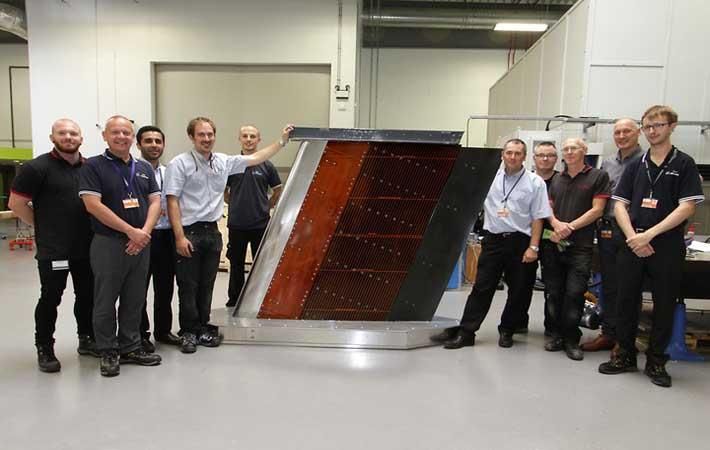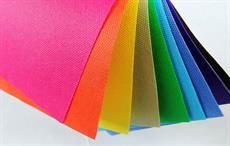Scientists have developed "smart" composite leading edges for aircraft wings which have embedded heaters to protect the wings against ice build-up, while reducing weight and boosting efficiency compared to existing systems, under a joint project involving University of Sheffield, and Boeing and aerospace companies Meggitt PLC and AeroTex UK.
Scientists have developed "smart" composite leading edges for aircraft wings which have embedded heaters to protect the wings against ice build-up, while reducing weight and boosting efficiency compared to existing systems, under a joint project involving University of Sheffield, and Boeing and aerospace companies Meggitt PLC and AeroTex UK.#
The £1 million-plus project has concluded successfully after crucial wind tunnel tests. The project called, Electro-thermal Laminar Wing Ice Protection System (ELWIPS) demonstrator, was funded by the European Union and it brought together researchers from the University of Sheffield Advanced Manufacturing Research Centre (AMRC) with those from Meggitt PLC and AeroTex UK. The programme is managed by aircraft manufacturer Dassault Aviation.
Scientists have developed "smart" composite leading edges for aircraft wings which have embedded heaters to protect the wings against ice build-up, while reducing weight and boosting efficiency compared to existing systems, under a joint project involving University of Sheffield, and Boeing and aerospace companies Meggitt PLC and AeroTex UK.#
ELWIPS, along with other innovative research programmes, aim to develop technologies which will feed into the next generation of aircraft.
Scientists have developed "smart" composite leading edges for aircraft wings which have embedded heaters to protect the wings against ice build-up, while reducing weight and boosting efficiency compared to existing systems, under a joint project involving University of Sheffield, and Boeing and aerospace companies Meggitt PLC and AeroTex UK.#
The AMRC designed and built a composite wing structure which incorporates innovative electric heating technology and power control systems developed by Meggitt subsidiaries in the UK and France, while world leaders in icing prevention and prediction, AeroTex, determined the sizing, zoning, power rating and control strategy for the heaters.
Scientists have developed "smart" composite leading edges for aircraft wings which have embedded heaters to protect the wings against ice build-up, while reducing weight and boosting efficiency compared to existing systems, under a joint project involving University of Sheffield, and Boeing and aerospace companies Meggitt PLC and AeroTex UK.#
A section of this wing was sent to the US for tests in a special wind tunnel operated by NASA.
Scientists have developed "smart" composite leading edges for aircraft wings which have embedded heaters to protect the wings against ice build-up, while reducing weight and boosting efficiency compared to existing systems, under a joint project involving University of Sheffield, and Boeing and aerospace companies Meggitt PLC and AeroTex UK.#
"The whole development process has taught us a tremendous amount and generated a lot of data that will be very useful in future projects," said Dr Tim Swait, technical lead at the AMRC composite centre.
Scientists have developed "smart" composite leading edges for aircraft wings which have embedded heaters to protect the wings against ice build-up, while reducing weight and boosting efficiency compared to existing systems, under a joint project involving University of Sheffield, and Boeing and aerospace companies Meggitt PLC and AeroTex UK.#
"The heating technology developed by Meggitt is very impressive and has great commercial potential. Tests in the NASA wind tunnel showed it could prevent ice from forming in the first place and would also shed ice if it was allowed to form on the wing," Swait said.
Scientists have developed "smart" composite leading edges for aircraft wings which have embedded heaters to protect the wings against ice build-up, while reducing weight and boosting efficiency compared to existing systems, under a joint project involving University of Sheffield, and Boeing and aerospace companies Meggitt PLC and AeroTex UK.#
If the system is developed commercially, it will be a major step forward for lighter aircraft and could have implications for the construction of greener large commercial aircraft, according to scientists.
Scientists have developed "smart" composite leading edges for aircraft wings which have embedded heaters to protect the wings against ice build-up, while reducing weight and boosting efficiency compared to existing systems, under a joint project involving University of Sheffield, and Boeing and aerospace companies Meggitt PLC and AeroTex UK.#
The ELWIPS project was part of the € 1.6 billion Clean Sky Joint Technology Initiative, which aims to develop breakthrough technologies to significantly increase the environmental performances of airplanes and air transport, resulting in less noisy and more fuel efficient aircraft.
Scientists have developed "smart" composite leading edges for aircraft wings which have embedded heaters to protect the wings against ice build-up, while reducing weight and boosting efficiency compared to existing systems, under a joint project involving University of Sheffield, and Boeing and aerospace companies Meggitt PLC and AeroTex UK.#
A number of different systems are currently used to protect aircraft against icing, which may drastically affect wing aerodynamics and have led to crashes in the past. One common system for jet airliners bleeds hot air from the aircraft engine and routes it along ducts in the leading edges, while another, seen on turboprop regional airliners and utility aircraft, uses rubber "boots" on the leading edges which can be inflated to force ice off.
Scientists have developed "smart" composite leading edges for aircraft wings which have embedded heaters to protect the wings against ice build-up, while reducing weight and boosting efficiency compared to existing systems, under a joint project involving University of Sheffield, and Boeing and aerospace companies Meggitt PLC and AeroTex UK.#
Both systems add weight and complexity to aircraft, while bleeding air from jet engines reduces their efficiency and in some circumstances boots have been known to fail, causing crashes.
Scientists have developed "smart" composite leading edges for aircraft wings which have embedded heaters to protect the wings against ice build-up, while reducing weight and boosting efficiency compared to existing systems, under a joint project involving University of Sheffield, and Boeing and aerospace companies Meggitt PLC and AeroTex UK.#
"You only actually need icing protection on a limited number of flights and for typically short periods of time, so you are carrying all that extra weight for no reason a lot of the time and aircraft of the future won't be able to use bleed air, since manufacturers are optimising their engines to extract every last bit of performance," said Swait.
Scientists have developed "smart" composite leading edges for aircraft wings which have embedded heaters to protect the wings against ice build-up, while reducing weight and boosting efficiency compared to existing systems, under a joint project involving University of Sheffield, and Boeing and aerospace companies Meggitt PLC and AeroTex UK.#
Electric heating has been difficult to implement on smaller aircraft because systems currently require substantial amounts of power. The ELWIPS project solves that problem by only using power when and where it is needed, instead of heating the leading edge of the whole wing. (SV)
Scientists have developed "smart" composite leading edges for aircraft wings which have embedded heaters to protect the wings against ice build-up, while reducing weight and boosting efficiency compared to existing systems, under a joint project involving University of Sheffield, and Boeing and aerospace companies Meggitt PLC and AeroTex UK.#
Fibre2Fashion News Desk – India


